Phil Simon's Blog
November 28, 2025
Black Book Friday Sale

Starting in late 2020, I began writing a series of books based on the rapidly changing future of work. They are:
The Nine: The Tectonic Forces Reshaping the Workplace . Low-Code/No-Code: Citizen Developers and the Surprising Future of Business Applications . Project Management in the Hybrid Workplace . Reimagining Collaboration: Slack, Microsoft Teams, Zoom, and the Post-COVID World of Work .Here's a carousel of my last four creations. (Hat tip Cathy Sarisky.)
 The Nine: The Tectonic Forces Reshaping the Workplace
The Nine: The Tectonic Forces Reshaping the Workplace
 Low-Code/No-Code: Citizen Developers and the Surprising Future of Business Applications
Low-Code/No-Code: Citizen Developers and the Surprising Future of Business Applications
 Project Management in the Hybrid Workplace
Project Management in the Hybrid Workplace
 Reimagining Collaboration: Slack, Microsoft Teams, Zoom, and the Post-COVID World of Work
figure.splide__slide { width: 100%; height: 100%; object-fit: contain; background-color: transparent; }.splide__slide img { width: 100%; height: 100%; object-fit: contain;}.splide { max-width: 100%}.splide__slide figcaption { position: absolute; display: none; padding: 16px; width: 100%;}.splide__slide:hover figcaption{ display:block; bottom:0; background: rgba(0, 0, 0, 0.5); color: #fff;}.splide__slide:hover { opacity: 1;} document.querySelectorAll('.splide figure').forEach(el => el.classList.add('splide__slide')); document.addEventListener( 'DOMContentLoaded', function() { var splide = new Splide( '.splide' , { type : 'loop', perPage : 1, perMove : 1, pagination : false, arrows : false, pauseOnHover: false, pauseOnFocus: false, arrows: true, gap: '3em', heightRatio: 1, breakpoints: { 600: { perPage: 1, perMove: 1, height: '60vh' } } } ); splide.mount(); } );
Reimagining Collaboration: Slack, Microsoft Teams, Zoom, and the Post-COVID World of Work
figure.splide__slide { width: 100%; height: 100%; object-fit: contain; background-color: transparent; }.splide__slide img { width: 100%; height: 100%; object-fit: contain;}.splide { max-width: 100%}.splide__slide figcaption { position: absolute; display: none; padding: 16px; width: 100%;}.splide__slide:hover figcaption{ display:block; bottom:0; background: rgba(0, 0, 0, 0.5); color: #fff;}.splide__slide:hover { opacity: 1;} document.querySelectorAll('.splide figure').forEach(el => el.classList.add('splide__slide')); document.addEventListener( 'DOMContentLoaded', function() { var splide = new Splide( '.splide' , { type : 'loop', perPage : 1, perMove : 1, pagination : false, arrows : false, pauseOnHover: false, pauseOnFocus: false, arrows: true, gap: '3em', heightRatio: 1, breakpoints: { 600: { perPage: 1, perMove: 1, height: '60vh' } } } ); splide.mount(); } );Because I wrote them as conceptual texts, they hold up well. A few have even won awards.
The DealI've got a few dozen extra paperback copies of each of them lying around that I really don't need. In the spirit of Black Friday, I'm selling signed copies of the four-pack. You get one of each.
Price: $60 (USD), including shipping (US only). When you check out, please include:
Your mailing address.How you'd like me to inscribe each book.Happy holidays.
LET'S DO THISNovember 25, 2025
The AI-Bayes Cocktail

As a sophomore at Carnegie Mellon a million years ago, I learned about Bayes' Theorem. (Thank you for your invaluable statistics classes, Professor Banks.) In case that admittedly obscure concept doesn't ring a bell, here's a simplified version of it:
We all face uncertainty when making decisions and predictions. That's life. To make more intelligent ones, we should regularly update our initial estimates based on new information.
Whether you realize it or not, you benefit from the work of Thomas Bayes. As but one example, his eponymous theorem has long helped tech companies minimize spam. (Decades after Bill Gates made his famous prediction, eradicating the problem remains a frustrating work in progress.)
Even better, you can and should actively apply this valuable construct to make better decisions. AI makes it easier than ever. Let those two sentences serve as a starting point for today's post.
A Simple ExampleSay that your manager fires you from your first job. He claims that you weren't cutting the mustard. You disagree and think that he was out to get you.
You find a new position, but after three months your new boss puts you on a performance improvement plan. Four weeks later, she axes you, too. Within 18 months, four separate managers have shown you the door.
Bayes' Theorem tells us that the problem is you—not them. (Cue Seinfeld reference.) Your previous three managers already shitcanned you based on your performance. Given that prior information, the odds that your fourth manager unjustly let you go are minute. (If you want to understand the math, this video is worth watching, and the statistically inclined will want to know its formula.)
 Image Source: CFI
Image Source: CFIYour supervisors didn't engage in a coordinated conspiracy to derail your career. Brass tacks: it's time for some serious soul-searching or a career change.
A Bit of History and the Ubiquity of BayesOnce you learn and understand Bayes' Theorem, you'll start noticing it everywhere. (I can't think of a better example of the Baader-Meinhof phenomenon in action.)
Thomas Bayes' work lives on centuries after his passing. As a 2011 book with an insanely long subtitle illustrates, the theory simply won't die. Bayes' Theorem does more than minimize spam. Much more.
It helps statisticians develop accurate models. Case in point: Nate Silver's career and 2012 book, The Signal and the Noise: Why So Many Predictions Fail—but Some Don't . Skilled poker players routinely use it to evaluate their hands and bets. I'm no pro, and I haven't sat at a poker table in years. Still, thinking about it helped me win more money than I lost. On a personal level, I often broached it when I taught the analytics capstone class at ASU.Below I explain how I used Bayes' Theorem and a little AI to decide whether to open a suspicious email.
November 18, 2025
AI Product Feature Amnesia

It's naïve, irresponsible, and dangerous to expect perfection from general-purpose AI chatbots. Claude, ChatGPT, and Gemini are certainly impressive, but only a fool believes they bat 1.000. Hallucinations are inevitable in trillion-parameter large language models trying to achieve artificial general intelligence. Always treat their claims and answers as dubious. The fleas come with the dog.
At the other end of the spectrum is weak or narrow AI. A tool that falls under this umbrella performs a discrete task better than humans can. Hawk-Eye is my favorite example of a system that does one thing exceptionally well: determine whether a tennis ball landed in or out. At a high level, we ask weak AI to do comparatively less while demanding far greater accuracy from it.
Somewhere in between these two extremes are AI companions that emphasize depth over breadth. These in-app chatbots don't purport to answer every conceivable question. Rather, companies design them to:
Tell customers exactly what their core products can and can't do. Let them interact with software via natural language. (Case in point: Salesforce's Einstein.) Help them save time, make better business decisions, and the like.At least that's the theory.
In today's post, I'll demonstrate yet another example of how AI companions are less accurate than they should be. One in particular exhibited an astonishing case of what I call AI product feature amnesia.
A Simple Product PromptI was curious about Notion's native ability to handle large surveys. I knew that it wouldn't be the best tool for the job but figured that I'd go straight to the source. Here's my prompt from earlier this month:
November 11, 2025
An Open Letter to Zoom Management

Dear Zoom Management:
You may remember me. In case you don't, here's a brief refresher on how we met five years ago.
On April 1, 2020, I signed a contract to write Zoom For Dummies. My acquisitions editor (AE) at Wiley initially conceived of a 200-page book fast-tracked for a summer publication date. Given Zoom's insane popularity at the time, no one wanted to miss out on potential sales. I needed to produce the entire manuscript within 60 days.
Game on.
Much More Than Skype 2.0As I dug into Zoom, it quickly became apparent that 200 pages was wholly insufficient. Zoom For Dummies needed to be longer than my publisher envisioned initially envisioned—much longer. Zoom undoubtedly functioned as a better, more modern version of Skype and Webex. Its videoconferencing helped countless organizations keep the lights on during unprecedented times. We used this feature to socialize and connect with our loved ones.
Still, videoconferencing represented just the tip of the Zoom iceberg. There was so much more to your useful, rock-solid suite of communications tools:
Zoom's core product also let users chat with—and send files to—others in their workspace. In this way, it reminded me of the popular instant message tools of the 90s.Third-party apps extended Zoom's native power.Zoom Webinars let people host large meetings.Zoom Phone allowed anyone to make affordable and reliable international calls via voice over internet protocol. Vonage users know what I'm talking about here.Zoom Rooms. Execs at your company generously gifted me one of these large, wall-mountable iPads. I was able to write that chapter with firsthand experience using the product. Zoom Room | Source:
Neat
Zoom Room | Source:
Neat
Zoom Rooms is particularly instructive for our purposes. It was then—and remains now—a standalone app. I wasn't in the room when Zoom engineering and product folks made that decision. If I had to guess, though, everyone realized the silliness of including every conceivable Zoom product and feature in a single app.
Someone forgot that lesson, but we'll return to that point later.
Course Correction: Revisiting the Book's LengthFor Dummies books on software applications need to provide step-by-step directions and screenshots. No human being could adequately explain all of your products' features in such a short text. When I explained as much to my AE, he agreed. He approved additional chapters on each of these topics. The May 31, 2020, deadline, however, remained firm.
I busted my ass and cranked out 111,000 words and all the screenshots. A few members of your senior team proved immensely helpful. One even reviewed the security and privacy chapter to ensure that I stuck the landing.
 Photo by Sander Yigin / Unsplash
Photo by Sander Yigin / UnsplashUltimately, Zoom For Dummies came in at nearly 400 pages—twice my AE's original estimate. Why your sales and marketing teams didn't buy copies of it by the truckload to give to different groups continues to mystify me.1 But hey, I wasn't making bank as your chief marketing officer.
📘Today, there are German, Dutch, and French editions of the book as well, not that I can read them.Zoom: The Last Five YearsMuch has happened in the past since mid-2020. Organizations are attempting to force employees back to the office. AI is everywhere. Rush announced a 2026 tour. (Boom.) Perhaps most germane here, like Peloton, Zoom's no longer the belle of the ball.
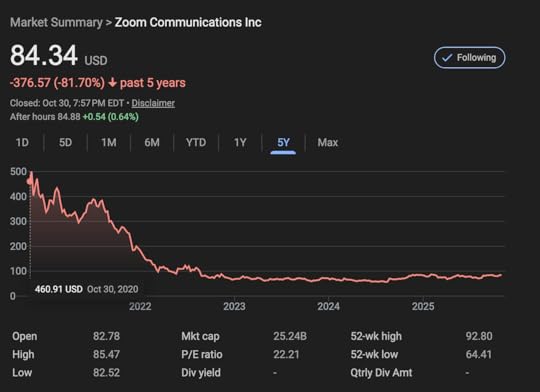 Zoom Five-Year Stock Performance
Zoom Five-Year Stock PerformanceSince my book dropped in August 2020, your company has changed many existing features and added some impressive new ones. Notable ones include:
Zoom Docs, including databases.Zoom Hub as a central asset manager, to use your verbiage. Zoom Mail and Calendar.Zoom Spaces for collaboration.Zoom Tasks.Zoom Scheduler.Zoom AI Companion 3.0.These moves make sense. The fact that you're continuing to add to your suite of tools makes me think that we're on the same page: rapid AI advancements mean that most niche software vendors will soon perish. Offer everything, and you become too big to fail.
But there's a problem.
Sign up for Simon SaysWeekly insights on AI, workplace tech, and more.
SUBSCRIBE .nc-loop-dots-4-24-icon-o{--animation-duration:0.8s} .nc-loop-dots-4-24-icon-o *{opacity:.4;transform:scale(.75);animation:nc-loop-dots-4-anim var(--animation-duration) infinite} .nc-loop-dots-4-24-icon-o :nth-child(1){transform-origin:4px 12px;animation-delay:-.3s;animation-delay:calc(var(--animation-duration)/-2.666)} .nc-loop-dots-4-24-icon-o :nth-child(2){transform-origin:12px 12px;animation-delay:-.15s;animation-delay:calc(var(--animation-duration)/-5.333)} .nc-loop-dots-4-24-icon-o :nth-child(3){transform-origin:20px 12px} @keyframes nc-loop-dots-4-anim{0%,100%{opacity:.4;transform:scale(.75)}50%{opacity:1;transform:scale(1)}} Email sent! Check your inbox to complete your signup.No spam. Unsubscribe anytime.
Spiraling Out of ControlIn the unlikely event that Wiley asked me to pen an updated version of Zoom For Dummies today, I'd immediately pass. The idea of writing a single book describing everything in the Zoom universe is risible—even if you announced another feature freeze. By the same token, only Chuck Norris could write a mammoth tome on Google Workspace or Microsoft 365 Copilot.
It's probably easier for me to list the things Zoom doesn't purport to do these days. Here's just a partial list of products and services from your website:
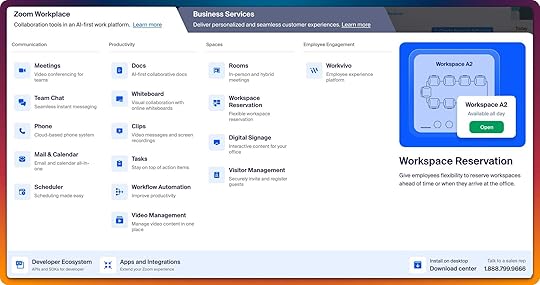 Partial Listing of Zoom Products and Services | Source: Zoom Website, November 1, 2025 | Click on the image to enlarge it.
Partial Listing of Zoom Products and Services | Source: Zoom Website, November 1, 2025 | Click on the image to enlarge it.I doubt that I'm telling you anything you don't know. You have to realize that the Zoom app has become nearly unusable. There's way too much going on. Maybe you're even rebuilding it as I type these words.
 Zoom Current User Interface | Click on the image to enlarge it.Navigation Nightmares
Zoom Current User Interface | Click on the image to enlarge it.Navigation NightmaresYou probably grouped all products and features into a single app to minimize user context switching. To be sure, it's an admirable goal. If I'm being kind, though, I'd describe the current Zoom experience as confusing. Put differently, the guy who wrote the definitive guide on your product five years ago sometimes struggles to find settings and features, but this post isn't about me. Plenty of others feel the same way.
“Please surround my app with random icons,” said no one ever. If there's a method to your default icon locations, I sure as hell can't figure it out. At least you offer users the option to customize the UI. I'm guessing that only a small percentage of your users know they can remove and rearrange superfluous icons.
Zoom in-app ads add even more clutter to an already disjointed user experience.
Of course, you're probably well aware of this problem. On the off chance you're not, though, contrast your product's current UI with the simple, clean ones of Notion, ChatGPT, and Claude:
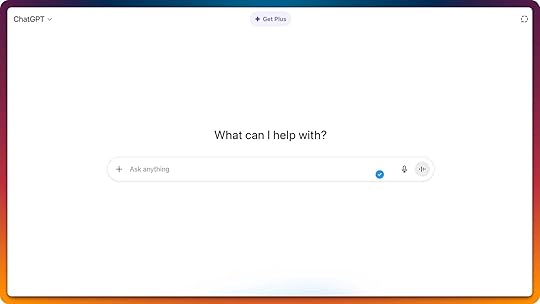 ChatGPT Current User Interface | Click on the image to enlarge it.
ChatGPT Current User Interface | Click on the image to enlarge it.The difference is stark. Zoom doesn't just need a new coat of paint. It has morphed into a Frankenstein app, and using it is downright painful.
💩 The Great Enshittification ContinuesOn a different level, I'm a customer on your Pro plan. I despise your in-app ads that incessantly and incorrectly prod me to upgrade my subscription. (If I were on your Free plan, I'd understand your not-so-gentle nudges.)
At least you've got plenty of company these days. Samsung just announced that it's taking a page out of this playbook for its refrigerators. Ditto for Apple's native Maps app. Enshittification marches on.Equal-Opportunity HallucinatorDeloitte’s irresponsible use of AI serves as a valuable and embarrassing reminder of its limitations.
 Phil SimonPhil Simon
Phil SimonPhil Simon The Solution: Kill Frankenstein
The Solution: Kill FrankensteinImagine a counterpart for Microsoft 365 Copilot today: a single UI or portal to access Microsoft Word, PowerPoint, Excel, Outlook, Teams, and OneNote. Ditto for Google Workspace or Apple's iWork.
Yikes.
Zoom's status quo simply is untenable. The product will only become more confusing as it adds more features and products.
Separate the current, bloated offering into multiple streamlined apps. I don't know the right number, but it exceeds one. Yeah, change is difficult, but your users will ultimately thank you.
Sincerely,
Phil Simon
Footnotes Teachers quickly come to mind.↩November 4, 2025
How AI Helps Me Understand My Author Royalty Statements

My first book, Why New Systems Fail, earned out in late 2010.1 Ever since then, publishers have sent me semi-annual royalty statements telling me how much money I could expect to receive from my books' sales. In today's post, I'll explain how AI helps me undertsand them in a fraction of the time it has historically taken me. Whether or not you've ever written a book, there's a larger lesson here.
BackgroundFirst, though, here's a bit of background for those of you unfamiliar with author royalty statements. I'll put this as delicately as I know how: they are confusing AF.
I'm hardly the only person to make this claim. The Authors Guild and Pearson even provide detailed guides on how to interpret them because these documents regularly resemble health insurance claims. On the final page, authors will find the amount of money the publisher is supposed to remit. If you owe your publisher, then the balance will be negative.
October 28, 2025
Superbloom

The prolific tech writer Nicholas Carr has penned some of the most memorable books I've read over the past fifteen years. The Big Switch: Rewiring the World, from Edison to Google drew fascinating parallels between electricity and cloud computing. The Shallows: What the Internet Is Doing to Our Brains helped me understand the great and dangerous rewiring taking place. His track record is solid, and I decided to give his latest effort a read.
Once again, Carr tackles a timely and compelling subject in Superbloom: How Technologies of Connection Tear Us Apart. (The book's title stems from a 2019 Instagram meme and the inevitable fallout.)
Illuminating Research: How We Got to NowTheorists have opined about the effects of new communication technologies for millennia. Yes, Superbloom provides the obligatory hat tip to Marshall McLuhan, but it also unearths plenty of surprises. As it turns out, lesser-known contributors were decades or even a century ahead of their time. One example is the prescient work of the American sociologist Charles Horton Cooley. The man coined the term social media in—ready for this?—an 1897 article.
October 21, 2025
How Not to Write Marketing Copy

Say that you were in the market for productivity software. You stumbled across an offering that billed itself as:
 Description of Anonymous Software Product
Description of Anonymous Software ProductDo you understand what you would be purchasing? Would you buy it?
The answer to both questions is probably no.
What software vendor posted this confounding, jargon-laden description of its wares?
Grammarly.
Yes, the very same Grammarly that, from its inception, built its brand on improving others' writing. Here's a screen grab from its March 2018 home page:
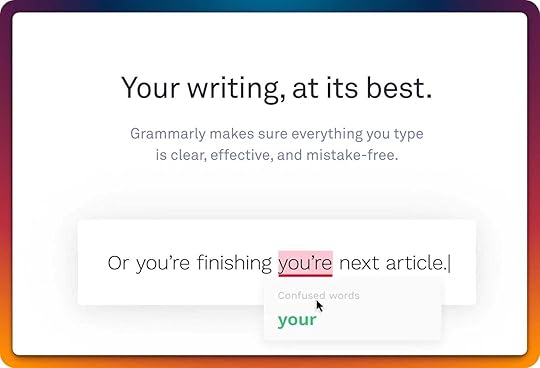 Grammarly Home Page | Source: Internet Archive
Grammarly Home Page | Source: Internet ArchiveRead the following sentence again and be honest:
October 15, 2025
Equal-Opportunity Hallucinator

Large language models can't distinguish fact from fiction. That's hardly news. Mildly intelligent college students know as much. They understand the risks of using AI chatbots willy-nilly to crank out term papers. Yet, the fact that ChatGPT and its ilk routinely hallucinate somehow evaded senior leadership at a top-tier consulting firm.
In today's post, I'll explain why. But first, here's a quick primer on how the consulting industry works.
Consulting 101: Profit Pressures and Turf WarsBoutique consulting shops with a few dozen employees pick a lane and stick to it; internationally recognized advisory ones with thousands of workers do not. Rather, they offer different arrays of services and solutions because their clients are so different. Boeing requires different consulting services than Chase and Banner Health do. One size does not fit all.
Take a job at Accenture, BCG, KPMG, McKinsey, PwC, and other big-ticket professional-service firms. You'll quickly discover that they tend to organize themselves into segments—or verticals, to use their parlance. Common examples include healthcare, retail, financial services, manufacturing, higher education, and the public sector.
These verticals operate as quasi-autonomous businesses within their massive parent companies. By themselves, they would be enormous enterprises. Exhibit A: Deloitte's public-sector vertical generated more than $12 billion last year—about one-sixth of the company's total revenues.
Impressive, but that amount is never enough. Pressure to increase each vertical's bottom line is incessant, especially at publicly traded firms. Can someone say stock options?
Regardless of whether John Q. Public can buy its stock, firm mandates to each vertical are clear:
October 14, 2025
A Case Study in No-Code Failure

YYZ is a successful mid-sized VC firm. A few years back, it conducted an extensive search for a new managing partner. Among the candidates who interviewed for the position, Adam clearly stood out from his peers. Yeah, he knew the industry, but no one else asked about YYZ's existing systems and tech. In short, they were a mess. Disparate Excel spreadsheets and a torrent of emails ruled the day.
Before accepting the position, Adam stressed the need to make significant tech changes after joining. First up: the firm needed to turn chaos into order—and that required adopting new tech. The popular magnet app Notion was squarely in his crosshairs.
 Photo by Isaac Smith / UnsplashBackground
Photo by Isaac Smith / UnsplashBackgroundIn his previous position, Adam had used the popular no-code tool. He was an unapologetic fanboy. Notion allowed everyone at his previous employer to easily retrieve key information, including:
The status of each deal.The ROI of each investment.A summary of weekly, monthly, quarterly, and annual performance. Total funds invested by industry. Which employees were closing which deals—and which were the most successful.People spent minimal time reconciling errors. Accurate reporting was a breeze. Things just worked. Why shouldn't YYZ function the same way?
A New Tool Begets the Same ProblemsAdam spent the first few months creating a bespoke Notion system. Not long after launching it, though, things at YYZ began rapidly devolving. Information in Notion sometimes conflicted with the company's bank statements, accounting system, internal emails, and signed, legally binding documents. Late-night data investigations were becoming commonplace.
In one particularly galling example, YYZ nearly remitted the same six-figure Series-A payment to a portfolio company twice. Six weeks later, a promising biotech startup opted to go with another VC firm because it was more organized.
Beyond these alarming one-off incidents, other system-related problems plagued the company. Although it used a top-tier tool, answers to simple business questions proved elusive. Here are a few:
Where do we stand with each deal?How much have we invested in each company and industry by stage? What is the status of each term sheet we've sent out? Who was the last person to talk to the potential portfolio company about a potential investment?Adam wasn't the only one peeved. The other YYZ partners were none too pleased at its current state of affairs.
Of course, it didn't need to be this way. Let's dive into what happened.
Root Cause AnalysisNotion was supposed to function as a single source of truth at YYZ. Instead, it had morphed into a morass of incomplete, outdated, missing, or duplicate information. Reports from it had become mere guides—starting points to find the truth. Some were downright meaningless. GIGO at its finest.
You may infer that YYZ's plight stemmed solely from its tech. Rest assured, it did not. As is usually the case, humans are to blame.
Duplicate Records and Conflicting InformationA galling lack of internal controls allowed anyone at YYZ to enter just about anything into Notion. Let's start with duplicate entries. Many employees who couldn't locate an existing record simply created a new one.
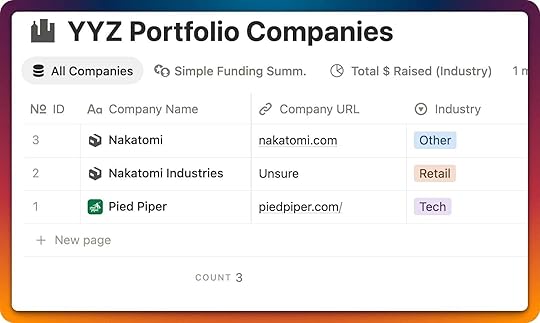 Duplicate Portfolio Company in YYZ Notion Database: | Click on the image to enlarge it.
Duplicate Portfolio Company in YYZ Notion Database: | Click on the image to enlarge it.You needn't be an expert in data modeling or master data management to appreciate the problems that this practice causes.
And then there were the issues related to an individual record's existing property—Notionspeak for a database field or column, if you like. Some employees created new, overlapping, and unnecessary properties that told different stories. Take deal status, for instance. NotionAI could help identify YYZ's discrepancies among three conflicting values, but it could not resolve them.
In a few cases, people took a DIY approach and created their own, separate Notion databases to track their deals. One rogue worker—a promising new hire—ignored Notion entirely and opted to use a Google Sheet.
So why was data quality at YYZ an utter mess? We need to keep asking why.
New Notion Template: Venture Capital & Investment TrackerA simple way to track investments, funding rounds, valuations, and much more. Phil SimonPhil Simon
Phil SimonPhil Simon Human Factors, Not Tech Ones
Human Factors, Not Tech OnesIn a way, Notion was destined to fail at YYZ—as was any new tool. The company failed to properly train its employees on its new system and related processes. What's more, Adam and his team failed to lock down Notion databases to prevent the very issues they'd soon encounter. To some extent, everyone was an admin.1
Many people blew off training sessions because they were too busy or had noodled with Notion on their own time.
GIGO at its finest
Adding salt to the wound, communication at YYZ was generally deficient. The company would make small but critical changes to its Notion system but fail to tell its workforce about them.
On Amoeba and NotionLow-code and no-code tools don’t fall neatly into a single category. Phil SimonPhil Simon
Phil SimonPhil Simon Simon Says: New Tools Require Planning
Simon Says: New Tools Require PlanningThe moral of this little yarn: Notion, Airtable, Coda, Loop, and other apps have enabled a new, fundamentally different type of tool builder. (It's a key point in my book Low-Code/No-Code). Citizen developers lack formal coding knowledge, but they have nonetheless created innovative solutions that have solved real problems. In many cases, their IT departments have thanked them for taking months of work off their plate.
In a way, no-code/low-code tools are just like their antecedents: Without sufficient database design, product support, change management, accountability, and training, they are just as likely to cause problems as they are to solve them.
Remember that truism the next time a software vendor's wares look too good to be true. The same holds true if you think you can build the plane as you're flying it.
Footnotes To be fair, Notion's lack of record-level permissions at the time exacerbated the problem.↩ need help building and deploying A NEW NOTION SYSTEM at your organization?Let me help your organization avoid the mistakes that YYZ and countless others make as they adopt Notion.
HIRE MEOctober 8, 2025
On Employee Expenses, Lazy Managers, and AI Agents

Starting in 2000, I worked at Lawson Software as an application consultant. The job typically involved descending on different organizations and setting up their new HR and payroll systems. As you'd expect, we consultants would need to book our own flights, hotels, rental cars, and the like. Even when flying coach, our weekly expenses could easily reach $2,500 or more.
Unfortunately, Lawson didn't provide us with company credit cards.1 As a result, my colleagues and I had to pay for our expenses out of our own pockets. We would then submit them to our managers for approval. Upon successful submission, Lawson's internal system sent daily short emails reminidng them to either:
Approve their pending expenses; orReject them with an explanation.In theory, consultant reimbursements would arrive in their bank accounts soon after that. In other words, the float would be ephemeral.
 Photo by NASA Hubble Space Telescope / UnsplashTheory and Practice Collide
Photo by NASA Hubble Space Telescope / UnsplashTheory and Practice CollideSadly, some employee loans weren't so fleeting. The cause for the delays wasn't technical. As is often the case, it was human.
My first manager (call her Denise here) routinely ignored these emails. A few weeks after I had submitted about $5,000 in expenses, I followed up with an email and a voicemail only to hear crickets.



